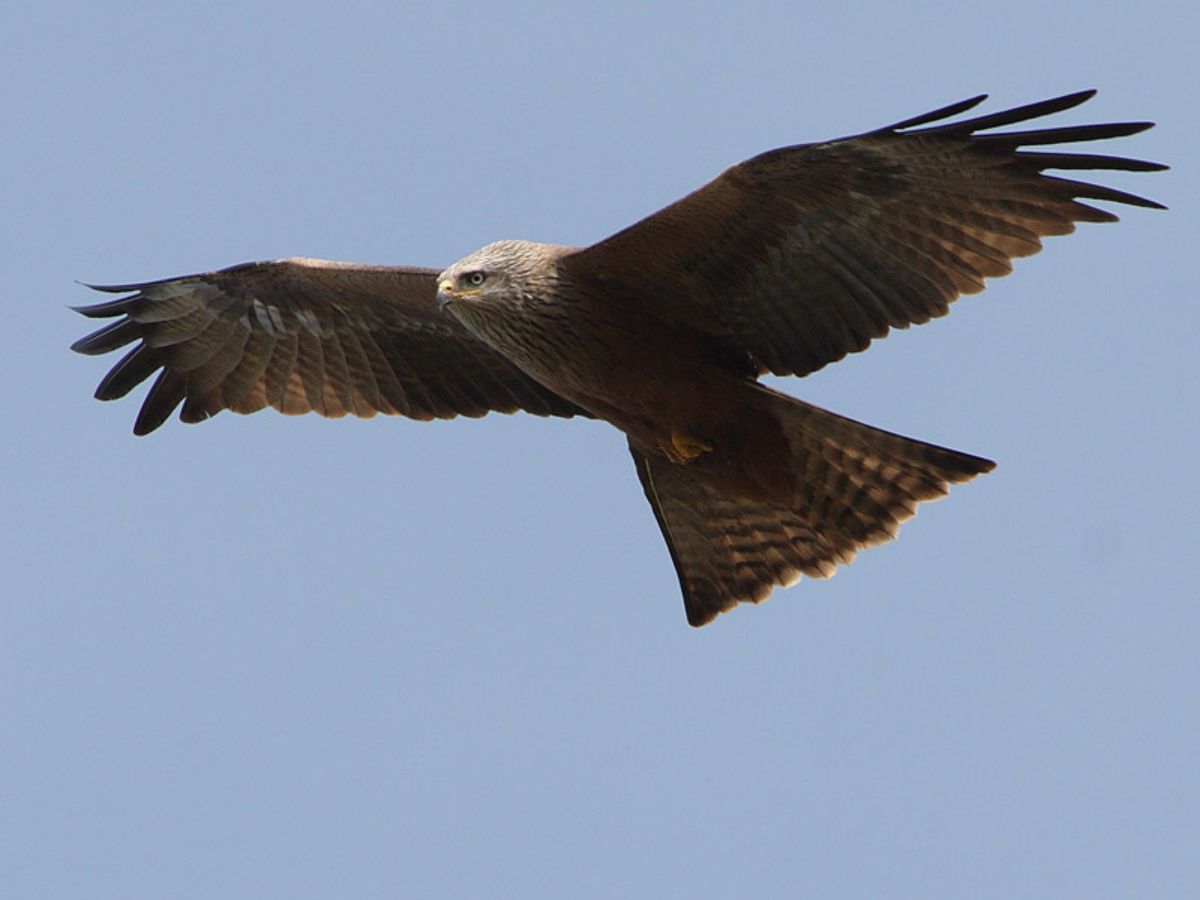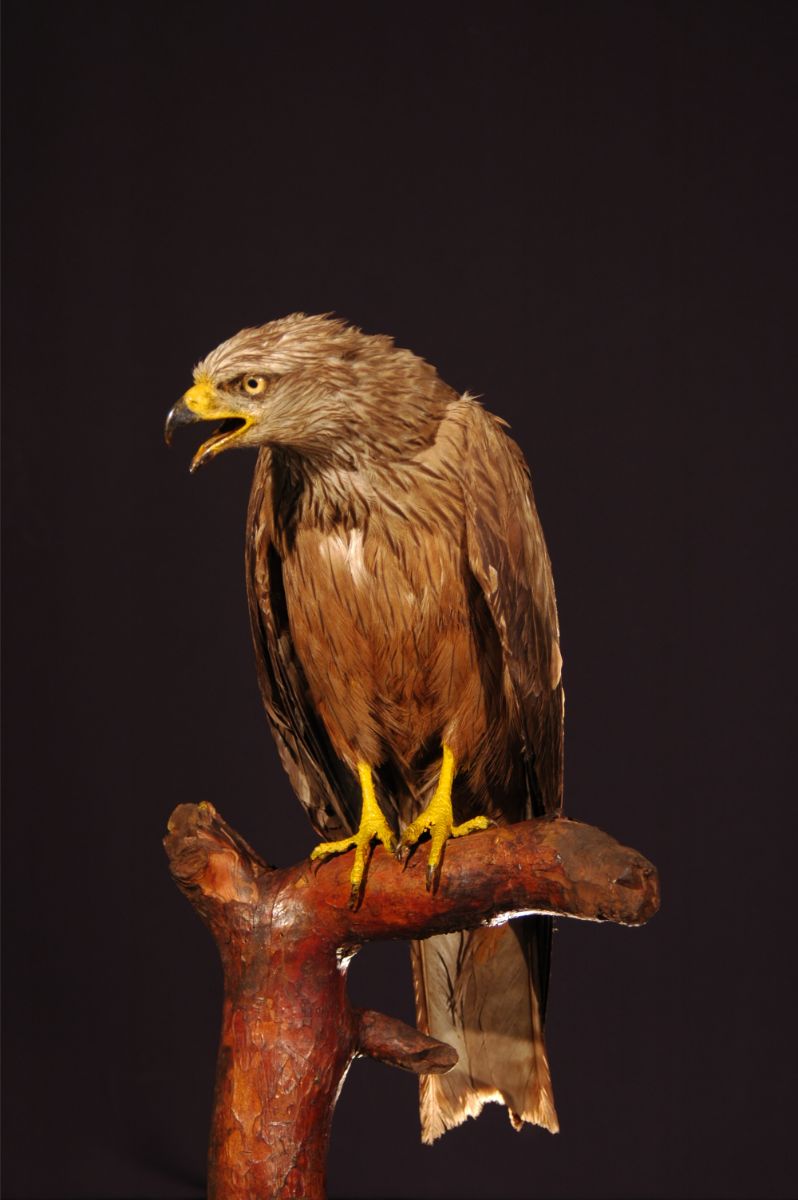Name
Milvus migrans
Black kite
Framing
Phylum: Chordata
Subphylum: Vertebrata
Class: Aves
Order: Accipitriformes
Family: Accipitridae
Genus: Milvus
Species: migrans
Habitat
Terrestrial. Areas with scattered trees, often near water and sometimes in towns. For hunting it prefers more or less open areas with grasslands, wastelands and mosaic landscapes, as well as riverbanks and wetlands.
Feeding
It is a purely carrion-eating species, specialising in the consumption of large ungulates, both wild and - at least in our territory - domestic, which is why it is closely linked to human grazing activities. Nowadays, it also frequently frequents rubbish dumps, where it obtains abundant remains.
Distribution
Europe, Africa, Asia and Oceania. In Europe, it occurs from the Mediterranean to less cold areas of the Nordic countries, although the most important population centres are in Russia, Spain, France and Germany.
Conservation status
In Spain it is considered almost threatened with extinction. It is classified as "Of special interest" in the National Catalogue of Threatened Species.
Additional information
Free-living. In pairs during breeding. This medium-sized, rather dark-coloured bird of prey is characterised by rather long wings and a long forked tail, though rather less so than that of its close relative, the red kite, which is more slender and larger. The adult is considerably dark coloured overall, but with a greyish, finely striped head; the underparts are somewhat reddish and longitudinally furrowed with elongated speckles, while the wing coverts are rather light-edged, defining a characteristic dorsal pattern (fig. 1). The tail is greyish-brown with abundant barring.
Additional information
Bibliography
- Arroyo, B. (1978). La alimentación del milano negro (Milvus migrans) en una localidad de España Central. Ardeola, 25, 47-57.
- BirdLife International (2008). Milvus migrans. En: IUCN 2008. 2008 IUCN Red List of Threatened Species. http://www.iucnredlist.org.
- Blanco, G. (1994). Seasonal abundance of black kites associated with the rubbish dump of Madrid , Spain. Journal of Raptor Research, 28 (4,: 242-245.
- Blanco, G. & Viñuela, J. (2003). Milano negro Milvus migrans. En: Atlas de las aves reproductoras de España (pp. 160-161). R. Martí, R. & Del Moral, J. C. (Eds.) DGCN-SEO/BirdLife, Madrid.
- Blanco, G. & Viñuela, J. (2004). Milano negro Milvus migrans. En: Libro Rojo de las Aves de España. (pp. 116-120). Madroño, A., González, C. & Atienza, J. C. (Eds.). MMA-SEO/BirdLife, Madrid.
- Blas, J., Cabezas, S., Figuerola, J., López, L., Tanferna, A. & Hiraldo, F. (2013). Carotenoids and skin coloration in a social raptor. Journal of Raptor Research, 47 (2), 174-184.
- Blas, J., Sergio, F. & Hiraldo, F. (2009). Age-related improvement in reproductive performance in a long-lived raptor: a cross-sectional and longitudinal study. Ecography, 32 (4), 647-657.
- Bustamante, J. & Hiraldo, F. (1989). Post-fledging dependence period and maturation of flight skills in the Black Kite Milvus migrans. Bird Study, 36, 199-204.
- Castaño López, J. P. (2010). Las rapaces diurnas y su conservación en Castilla-La Mancha. Gráficas Marte, Fuenlabrada.
- Cramp, S. & Simmons, K. E. L. (Eds.) (1980). Handbook of the Birds of Europe the Middle East and North Africa. The Birds of the Western Palearctic. Volume II. Hawks to Bustards. Oxford University Press, Oxford.
- Jones, A. M. & Mañez, M. (1990). Cannibalism by black kite (Milvus migrans). Journal of Raptor Research, 24 (1-2), 28-29.
- López-Jiménez, L., Blas, J., Tanferna, A., Cabezas, S., Marchant, T., Hiraldo, F. & Sergio, F. (2016). Ambient temperature, body condition and sibling rivalry explain feather corticosterone levels in developing black kites. Functional Ecology, 30 (4), 605-613.
- Madroño, A., González, C. & Atienza, J. C. (Eds.). (2004). Libro Rojo de las Aves de España. MMA-SEO/BirdLife, Madrid.
- Martí, R. & Del Moral, J. C. (Eds.). (2003). Atlas de las aves reproductoras de España. DGCN-SEO/BirdLife, Madrid.
- Martín, A. & Lorenzo, J. A. (2001). Aves del Archipiélago Canario. Francisco Lemus Editor, La Laguna.
- Palomino, D. (2012). Milano negro. Milvus migrans. En: Atlas de las aves en invierno en España 2007-2010 (pp. 1162-163). Del Moral, J. C., Molina, B., Bermejo, A. & Palomino, D. (Eds.). Ministerio de Agricultura, Alimentación y Medio Ambiente-SEO/BirdLife, Madrid.
- Sergio, F., Blas, J., Forero, M., Fernández, N., Donázar, J. A. & Hiraldo, F. (2005). Preservation of wide-ranging top predators by site-protection: Black and red kites in Doñana National Park. Biological Conservation, 125, 11-21.
- Veiga, J. P. & Hiraldo, E. (1990). Food habits and the survival and growth of nestlings in two sympatric kites (Milvus milvus and Milvus migrans). Holarctic Ecology, 13, 62-71.



